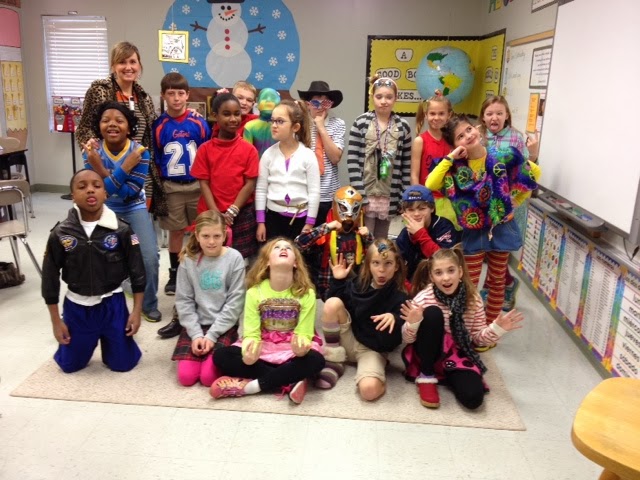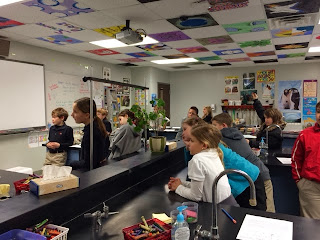Wednesday, January 29, 2014
Updated Schedule
Wow! What a fun week! Enjoy your extra day out of school playing in the snow! We have adjusted the schedule due to school being cancelled for Thursday. We WILL have our Space Day this Friday as planned. The unit 19 spelling test will also be this Friday and the unit 19 homework will be due at the same time. The Bible verse (Zeph 3:17) will be due next Thursday, Feb. 6th. The LWW vocab quiz (ch. 7-10) will be Tuesday, Feb 4th. We can't wait to see you Friday!
Tuesday, January 28, 2014
Happy Snow Day!
Language Arts quizzes and tests originally scheduled for Wednesday (LWW vocab) and Thursday (Spelling) have been rescheduled. The unit 19 Spelling homework will be due Friday, and the unit 19 Spelling test will be given Friday morning before we begin our Space Day activities. The LWW vocab quiz will be given next Tuesday. The Bible verse (Zeph. 3:17) originally scheduled to be written this Thursday will be due this Friday. Enjoy your snow days! We can't wait to see you Thursday morning!
Tuesday, January 21, 2014
Friday, January 17, 2014
Life in a Snow Globe
Stop by the fourth grade hall and see our descriptive writing pieces titled "Life in a Snow Globe". They are full of sensory details and similes! Here are a few samples:
Countdown to our Space Unit Test...
The students have literally had a blast learning so much about space exploration, flight, and astronomy! With our space vocabulary quiz behind us, it is time to get ready for next Friday's Space Exploration Test (1/24). Students were given their study guides today. A copy is also included for you here as well. Thanks so much for all that you do at home!!!
Space
Exploration—Test
Study Guide
Students
should be able to:
·
List the planets in order from the sun
and identify the inner and outer planets (My
Very Excited Mother Just Served Us Noodles).
o
Inner Planets (Mercury, Venus, Earth, Mars)
o
Outer Planets (Jupiter, Saturn, Uranus, Neptune)
·
Identify Pluto as a dwarf planet.
·
Explain that the tilt of the earth on
its axis as it orbits around the sun is what causes the seasons.
·
Identify the 4 seasons in order (winter, spring, summer, fall).
·
Know the difference between a day and
a year.
(Day=1 rotation of earth on its axis/24 hours, Year=1 orbit of the earth
around the sun/365.2 days)
·
Identify
and label the phases of the moon. (Hint=the
moon appears on the right when it is waxing or appears to be getting bigger;
the moon appears on the left when it is waning or appearing to become less.)
(New Moon, Waxing Crescent, First Quarter, Waxing Gibbous, Full Moon, Waning Gibbous, Last Quarter, Waning Crescent)
·
Know these facts about space
exploration:
President who supported space
exploration=Kennedy
Countries in the Space Race=USA and
Russia
Father of Modern Rocketry=Goddard
First Human in Space=Gagarin (Russia)
First Person to Orbit the Earth=Glenn
(USA)
First People on the Moon=Armstrong,
Aldrin, Collins* (USA)
The Name of Their Moon Mission=Apollo 11
The Name of Their Moon Mission=Apollo 11
First American Woman in Space=Sally
Ride
Famous Russian Dog in Space=Laika
Famous American Monkeynauts=Able and
Baker
List 2 other interesting animals in
space=Mice, Crickets, Frogs, Turtles, Worms, Newts, etc.
2 shuttles were lost in the American
Shuttle Series=Challenger and Columbia
·
Know these facts about stars:
o
The sun is our closest star and is the
star at the center of our solar system.
It is a yellow star.
o
Blue-white stars are the hottest
stars.
o
Red stars are the coolest stars.
o
An exploding star is called a
supernova.
o
Our galaxy is called the Milky Way.
Friday, January 10, 2014
Blasting Off in 2014!














Space Exploration—Vocabulary
Study Guide
Inner Planets—the small,
solid, rocky planets between the sun and the asteroid belt
1.
Mercury—the smallest
planet, which is also closest to the sun
2. Venus—the hottest and brightest planet; a day
on this planet is longer than a year and it rotates in the opposite direction
of Earth
3.
Earth—the planet on
which we live that is perfectly designed by God for human, plant, and animal
life; it is also the only planet with liquid water
4. Mars—the “red” planet whose red color comes
from the iron in soil and rocks, like rust
Outer Planets—the large,
gaseous planets that are beyond the asteroid belt
5.
Jupiter—the largest
planet, known for its huge storm, the Great
Red Spot
6. Saturn—this ringed planet has such a low
density that it could float on water; its north pole jet stream is in the shape
of a hexagon
7.
Uranus—this greenish
planet has an extreme tilt and 11 very thin rings
8. Neptune—this cool blue planet is furthest from
the sun and is sometimes called the Ice
Giant
Dwarf Planet—an object in
space, smaller than a true planet, that orbits the sun but may not stay in its
own orbit (examples include Ceres and Pluto)
ISS—the
International Space Station (an experiment facility orbiting earth where up to
7 astronauts from various countries can safely live and conduct experiments in
space)
NASA—National
Aeronautics and Space Administration of the US (the agency of the United States
government that is responsible for the nation's civilian space program and for
flight and space research)
Astronaut—a person who
travels in space
Asteroid—a space rock
orbiting the earth, mainly found between Mars and Jupiter
Comet—a small frozen mass
of gas, dust, and ice that may have a nucleus, a coma, and a tail
Rotate—what the earth
does on its axis (approximately 24 hours)
Revolve—what the earth
does around the sun (approximately 365 days)
Seasons—each of the four
divisions of the year (spring, summer, autumn, and winter) that are marked by
weather patterns and daylight hours and that result from the earth's changing
position with regard to the sun.
Star—a ball of hot,
bright gas that produces energy by a nuclear reaction; the sun is an example
Constellation—a group of stars
within a region of the night sky that are said to look like animals or
mythological characters
Solar System—the sun and
everything that revolves around it
Galaxy—a huge system or
family of stars; our galaxy is called the Milky
Way
Astronomy—the study of
stars and planets
Subscribe to:
Comments (Atom)
















